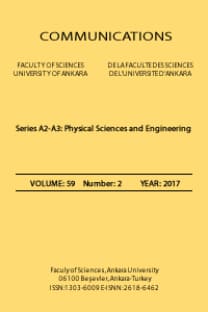THE DESIGN OF STANDALONE PV SYSTEM USING P&O ALGORITHM FOR MAXIMUM POWER POINT TRACKING
MPPT, DC-DC Converter, P and Q algorithm
___
G.J.G. Jothi, N. Geetha, “An Enhanced MPPT Technique for High Gain DC-DC Converter for Photovoltaic Applications”, 2016 International Conference On Circuit, Power And Computing Technologies [ICCPCT], 2016 IEEE, 2016.A. Haque, “Maximum Power Point Tracking (MPPT) Scheme for Solar Photovoltaic System”, Energy Technology& Policy (2014) Published with License by Taylor & Francis Group LLC, 2014, pp. 115-122.
M. Bodur, M. Ermiş, “Maximum Power Point Tracking for Low Power Photovoltaic Solar Panels”, IEEE Electrotechnical Conference Proc, 1994, pp. 758-761.
A. Attou, A. Massoum, M. Saidi, “Photovoltaic Power Control Using MPPT And Boost Converter”, Balkan Journal of Electrical&Computer Engineering, 2014, vol. 2, no. 1, pp.23-27.
T. Salmi, M. Bouzguenda, "Matlab/Simulink based modelling of solar photovoltaic cell", International Journal of Renewable Energy Research, Vol. 2, no. 2, 2012.
N. Mhiri, A. Alahdal, H. Ghulman, A. Ammous, “A Novel Analog Circuit Design for Maximum Power Point Tracking Of Photovoltaic Panels”, Advances in Power Electronics, 2017, pp. 1-9.
T. Chaitanya, Ch. Saibabu, “Modeling and Simulation of PV Array and its Performance Enhancement Using MPPT (P&O) Technique”, International Journal of Computer Science & Communication Networks,Vol 1(1), 2011.
S. Sholapur, K.R. Narsimhegowda, “Boost Converter Topology for PV System with Perturb And Observe MPPT Algorithm”, IOSR Journal Of Electrical And Electronics Engineering (IOSR-JEEE), vol.9, no. 4, 2014, pp.50-56.
M. Ferchichi, N. Zaidi, A. Khedher, “Comparative Analysis for Various Control Strategies Based MPPT Technique of Photovoltaic System Using DC-DC Boost Converter”, 17th International Conference on Sciences and Techniques Of Automatic Control & Computer Engineering- STA’2016, 2016 IEEE, 2016, pp.532-539.
H. Bounechba, A. Bouzid, K. Nebti, H. Benalla, “Modeling and Simulation of Perturb and Observe MPPT Algorithm For Pv Systems”, International Conference STA’2013.
M. G. Villalva, J. R. Gazoli, E. R. Filho, “A Study of Maximum Power Point Tracking Algorithms for Stand-alone Photovoltaic Systems”, IEEE Applied Power Electronics Colloquium (IAPEC) 2011.
M. S. Ngan, C. W. Tan, “Analysis ans Simulation of The P&O Algorithm Using A Linearized PV Array Model”, IECON’09 Industrial Electronics Conference, 2009. P.P. 231-236.
M. Z. Erel, M. Özev, A. Karaarslan, “The Comparison of OCC and PI Control Method for DC-DC Boost Converter”, IATS’17 8th International Advanced Technologies Symposium, 2017.
- ISSN: 1303-6009
- Yayın Aralığı: Yılda 2 Sayı
- Başlangıç: 2019
- Yayıncı: Ankara Üniversitesi
EVALUATION OF MS-DIAL AND MZMINE2 SOFTWARES FOR CLINICAL LIPIDOMICS ANALYSIS
RF ANTENNA DESIGN FOR BUTTON-TYPE BEAM POSITION MONITORS USING BIO-INSPIRED OPTIMIZATION METHODS
Ayhan AYDIN, Gazi Erkan BOSTANCI
AN ARTIFACT REDUCTION METHOD FOR BLOCK-BASED VIDEO CODING
Hakki Alparslan ILGIN, Ahmet AKBULUT
A STUDY ON THE SEARCH POTENTIAL OF DOUBLY CHARGED LEPTONS AT THE SppC BASED ep COLLIDERS
Aysuhan OZANSOY, Oğuzhan ALBAYRAK
THE DESIGN OF STANDALONE PV SYSTEM USING P&O ALGORITHM FOR MAXIMUM POWER POINT TRACKING
LEARNING DENSE CONTEXTUAL FEATURES FOR SEMANTIC SEGMENTATION
Hacer YALİM KELES, Long Ang LİM
THE DESIGN OF STANDALONE PV SYSTEM USING P&O ALGORITHM FOR MAXIMUM POWER POINT TRACKING
BAND REDUCTION FOR TARGET DETECTION IN HYPERSPECTRAL IMAGES
Murat ŞİMŞEK, Hakki Alparslan ILGIN
